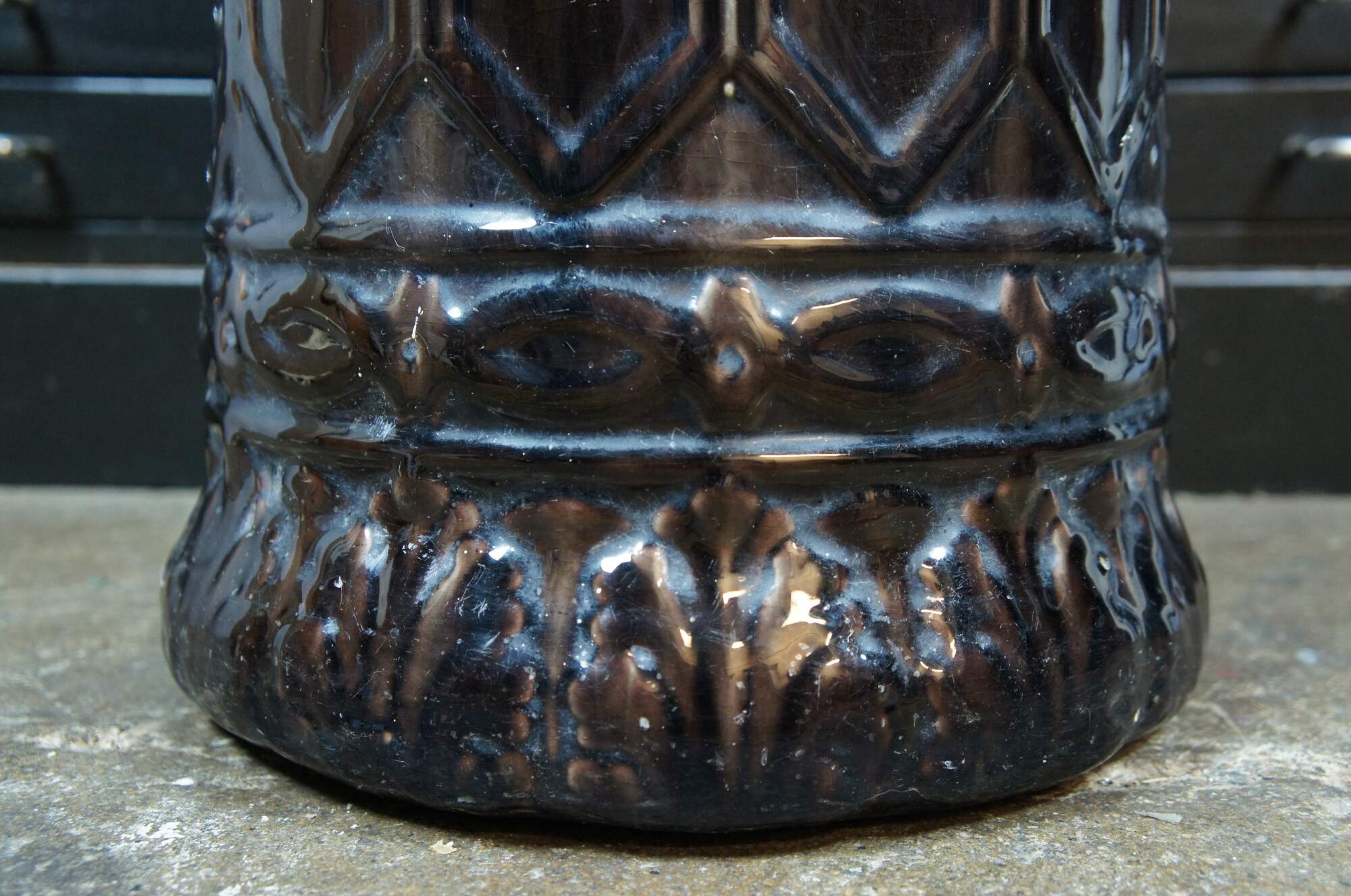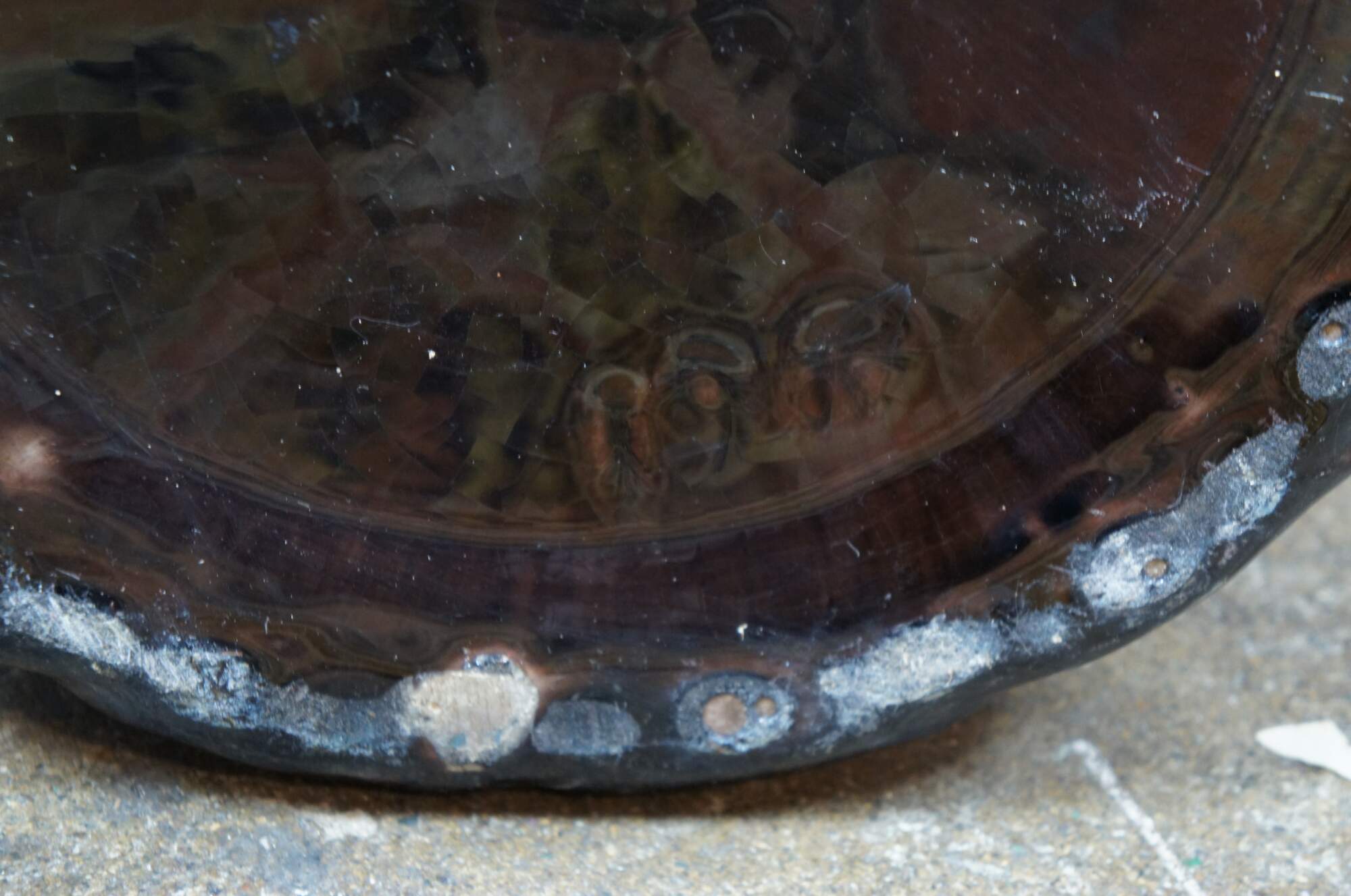
Antique Brush McCoy Green Brown Glaze Majolica Pottery Umbrella Cane Stand 23"
Sold
Shipping:
Free Shipping Included
Delivery:
Estimated 2-15 Business Days
Payments:
Credit Card, Check, Cash, PayPal, Apple Pay, Venmo
Returns:
30 Days 100% Money Back Guarantee, Buyer Pays Return Shipping
Description
Early 20th century antique Victorian / Edwardian circa 1915 Brush McCoy blended majolica pottery umbrella stand with a green and brown drip glaze. Cylindrical form with wider top and base, molded with a beautiful art neuveau design of fan / palm leaf trim and elongated diamond cartouches. Base appears to be incised with the number 198.
Umbrella stand 61 can be found on page 5 of Sanford's Guide to Brush-McCoy Pottery Book 2 by Martha and Steve Sanford.
In 1848, J.W. McCoy was born and raised in Putnam, which is now part of Zanesville, Ohio. He was married in 1870, and the next year he and Sarah (Sade) Elizabeth Brown his wife, moved to Uniontown in Newton Township, Muskingum County. There J.W. operated a dry good store.
In 1871, the McCoy’s moved to the community of Roseville, Ohio. There he entered into about a five-¬year partnership with his father-in-law, James E. Brown in a general merchandise business, which was called “Brown & McCoy”.
Then in 1876, J.W. opened a General Merchandise store on his own. In 1886, he entered into a partnership and established the “Williams and McCoy Pottery Co.”. After about four years of operation a new partner was taken in and the pottery was renamed the “Kildow, Williams and McCoy Pottery Co.”. According to, “The Business Review of Muskingum County”, “This plant was one of the most extensive in the valley and produced all kinds of common stoneware and a variety of culinary utensils.”
Then in 1890, after about two more years of operation, the KW&M pottery was renamed again, and was called the Midland Pottery Co. By 1892, J.W. was not only involved in pottery manufacturing, and retail pottery sales, but he had become a pottery jobber, selling bulk wares to wholesale dealers.
After about two years of operation, the KW&M pottery was renamed again, and was then called the “Midland Pottery Co.”. By 1892, J.W. was not only involved in pottery manufacturing, and retail pottery sales, but he had become a pottery jobber, selling bulk wares to wholesale dealers.
In 1898, following about six years of operation under the name the Midland Pottery Co., the pottery was sold to the “Roseville Pottery Co.”. This ended the partnerships J.W. had in the pottery business. Since very few pieces from these early potteries that J.W. was affiliated with have been found, it is most likely that most of them were unmarked.
As discussed in, “The History of the W. Nelson McCoy’s Blue Bird Pottery”, (seen elsewhere on this Web site), Wilber F., the cousin of J.W., was a partner in the “Zanesville Hardware Company”. The date that Wilber’s part-ownership in the store was established remains uncertain, but it was probably between 1870 and 1875.
In 1899, J.W. along with several investors, formed a pottery solely under his name, the J.W. McCoy Pottery Co. He must have devoted much of his time to his new pottery, for in 1901, he turned the management of his general store over to his son Arthur.
For several years, the “J.W. McCoy Pottery Co.” concentrated on the production of the simpler, utilitarian stoneware pieces. However, around late 1902 the pottery branched out and began to include the production of art pottery. The art pottery production consisted of elaborately designed, decorative items such as jardinières and pedestals, various other flower containers, umbrella stands, and sand jars. The production of these attractively glazed pieces proved to be a very successful undertaking.
In 1909, George Brush joined the “J.W. McCoy Pottery Co.”. Prior to that time he had established a pottery under his own name. However, the pottery only operated about one year before a fire destroyed the entire plant. The “Brush Pottery” was not rebuilt, but he retained the remaining assets of the Brush Pottery. Later in the year after his pottery burned, George Brush became the Manager of the “Globe Stoneware Company”, and the “Crooksville Clay Products Company”.
After joining the “J.W. McCoy Pottery”, within two years George Brush had become the General Manager of the pottery. In October of that year, the directors of the McCoy pottery decided to expand the pottery by the purchase of the “Globe Stoneware Co.” (1901-1911).
During August of 1911, George Brush, acting on behalf of the Brush Pottery interests, purchased the old “J.B. Owens Pottery”, Plant Number One in Zanesville (1883-1909), along with the equipment and molds. Late in 1911, the officers of the “J.W. McCoy Pottery”, at the suggestion of George Brush, agreed to combine the assets of the company with those of the “Brush Pottery”. Consequently, George Brush obtained the controlling interest in the “J.W. McCoy pottery”, and the name of the pottery was changed to the “Brush – McCoy Pottery”.
In 1912, the “Brush-McCoy Pottery” purchased the equipment and molds from the “A. Radford Pottery”, which was located in Clarksville, West Virginia.
In 1918, the McCoy family sold their interest in the Brush – McCoy Pottery; however, it was not until late 1925 that the directors of the pottery dropped the McCoy name. The new name of the pottery was the Brush Pottery Co., and it operated under that name until it closed in 1982.
Condition
Good Overall - wear and distressing from age and use, chip on rim, crazing.
Dimensions
11.25" x 22.5" (Diameter x Height)









